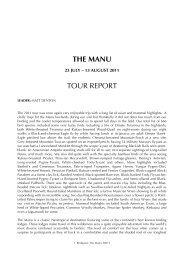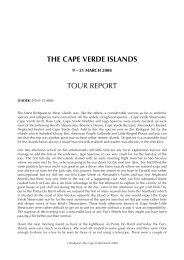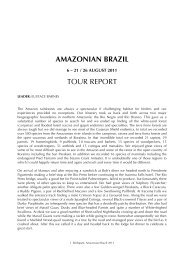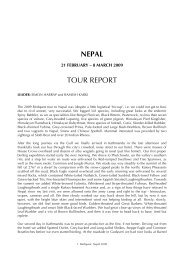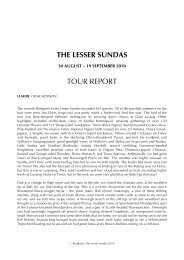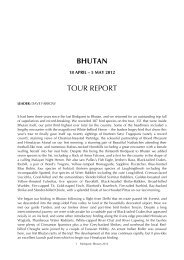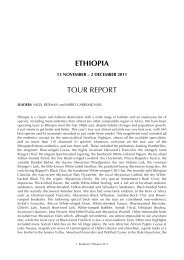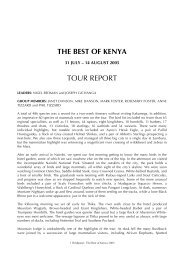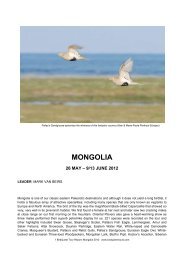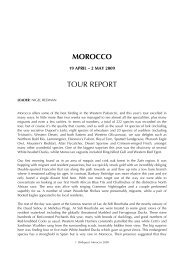SPITSBERGEN TOUR REPORT - Birdquest
SPITSBERGEN TOUR REPORT - Birdquest
SPITSBERGEN TOUR REPORT - Birdquest
Create successful ePaper yourself
Turn your PDF publications into a flip-book with our unique Google optimized e-Paper software.
Atlantic Puffin Fratercula arctica: This much-loved harlequin of a bird was seen well on a number of<br />
occasions at sea, both in flight and on the water. The total breeding population in<br />
Spitsbergen is thought to be in the range 10,000-100,000 pairs.<br />
TURDIDAE<br />
Common Blackbird Turdus merula: A male was found by Alan at the Husky kennels in Ny Ålesund<br />
and was later observed by many of us, while we were admiring our first Ivory Gull. The<br />
well-known Common Blackbird is a vagrant to Spitsbergen. There are only a few<br />
documented observations.<br />
EMBERIZIDAE<br />
Snow Bunting Plectrophenax nivalis: The only breeding passerine in the islands, but common,<br />
conspicuous and always a delight to behold. Its cheerful little song was to be heard at<br />
almost all of our landing sites, and even from the cliffs at Alkefjellet in Hinlopen Strait.<br />
MAMMALS<br />
Arctic Fox Alopex lagopus: Encountered on a couple of occasions, but usually rather wary. We saw<br />
one at Blomstrandhalvøya and enjoyed prolonged views of a female with seven pups in<br />
the middle of Ny Ålesund. This attractive little fox is still hunted in Spitsbergen.<br />
Polar Bear Thalarctos maritimus: The obvious highlight of the tour and probably the main reason for<br />
most of us to visit the spectacular Spitsbergen archipelago. We had three encounters with<br />
this most powerful arctic predator, all on the day when we were exploring the pack ice to<br />
the north of the islands. Our first was spotted while walking on the ice in the distance,<br />
and by careful manoeuvring of the ship we managed to keep it in sight for twenty<br />
minutes. The second animal was found at much closer range and stunned us all by<br />
coming towards the ship and allowing fantastic views while swimming and inspecting us.<br />
When it finally realized we were a bit out of its league it walked away slowly over the<br />
pack ice. Another animal was found in the distance at the same time. Good photos were<br />
obtained and everyone was in high spirits after this magical experience. Polar Bears used<br />
to be hunted in Spitsbergen. There is the amazing record of hunter Arthur Oxaas who<br />
shot 373 Polar Bears in 30 years in the middle of the 20 th century.<br />
Walrus Odobenus rosmarus: The first of the trip was a swimming individual at Alkefjellet. We then<br />
saw two at sea off Moffen Island, but our best encounter was at Poolepynten on Prins<br />
Karls Forland where we were able to admire, observe and photograph a group of about<br />
30 impressive animals on the beach or in the water at fairly close range. All were males,<br />
as indeed are all the Walruses in Spitsbergen at this time of year, as the female go<br />
elsewhere to give birth to their calves.<br />
Ringed Seal Phoca hispida: We only saw a small number of these wary animals at the edge of the<br />
pack ice.<br />
Bearded Seal Erignathus barbatus: Thirteen encounters with this large sausage with whiskers.<br />
Northern Minke Whale Balaenoptera acutorostrata: Three observations of this small, but distinctive<br />
whale. This is the commonest baleen whale in the waters around Spitsbergen, but still<br />
rather uncommon.<br />
Humpback Whale Megaptera novaeangliae: Great views of a frequently breaching animal at the<br />
Walrus spot on Prins Karls Forland. The long flippers could easily be discerned. A great<br />
showing.<br />
Beluga (White Whale) Delphinapterus leucas: Late at night, John found a pod of ten or so as we were<br />
sailing out of the Hinlopen Strait and some of us still managed to get distant views of<br />
these attractive whales. We also saw one while observing the Walruses on Prins Karls<br />
Forland.<br />
Reindeer (Caribou) Delphinapterus leucas: Encountered wherever there were large areas of snow-free<br />
tundra, generally in ones and twos, but occasionally in scattered groups of ten or more.<br />
8 <strong>Birdquest</strong>: Spitsbergen 2007




